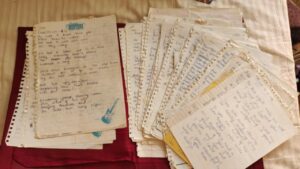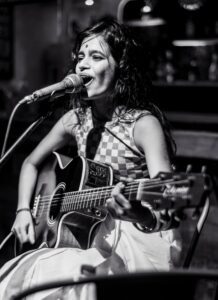Singer-songwriter Savithry Namboodiripad has been redefining genres by finding a balance between Carnatic and Western music.

Savithry studied at the renowned KM Music Conservatory (KMMC), Chennai — a music institute founded by AR Rahman. (Supplied)
Seated in front of her guitar with shrines dedicated to the goddesses Bhoomi, Kali, and Aphrodite watching over her, Savithry Namboodiripad, a singer-songwriter from Kerala, introduced me to her musical persona, Lopa Mudra.
Although she was christened only in 2015, Lopa Mudra had always been in Savithry’s life, following her closely. “There was no particular time she was born because I felt like I always had her,” Savithry reveals.
After her most recent performance at Chennai’s Circle of Love music festival on 22 July, it’s clear that Lopa Mudra has taken the front stage.
Savithry’s childhood was spent in Thrippunithura in the city of Kochi, after her family relocated from Assam, where her father was employed.
A locality that is home to a majority of the Varmas and Namboodiris, Thrippunithura was near Savithry’s illam (ancestral home) as well as her school.
As such, she grew up around family and friends, imbibing tradition while catching on to trends.
With Layam Ground just next door to her apartment and a temple not too far ahead, Savithry’s day began with communist anthems and prayer songs synchronously playing in the background.
To add to this cross-bred playlist, her brother’s interest and involvement in metal, punk, and rock, introduced her to power chords, sardonic lyricism, and an unrelenting expression of the self.
Since the first day of kindergarten, Savithry remembers herself as someone always ready to go on stage.
“In my heart, I’m a performer,” she shares.
While it was clear that her passion was directed towards the performing arts, she was yet to discover what skill she could take with her onstage.
“Knowing what exactly I wanted to do came from a lot of introspection; realising what kind of impact I want to make on people, how I want to make people feel,” she says.
“That’s when I realised that I always had this one skill in my disposition — writing,” she expresses. Growing up in a television-free household, reading and writing became her childhood pastimes. “That shaped me as a songwriter,” she says.

Savithry retains a file that preserves all her writings from her pre-teen days. (Supplied)
Although she has been writing as far as she can remember, it was around the age of 11 that her personal life and innermost feelings saw the surface of a paper.
“If you’re feeling overwhelmed with a particular emotion, what you do is, you pick up your pen and write away,” she suggests.
As a testament to that practice, she still has a file that contains all her writing from her pre-teen days — withering Hannah Montana notebook pages stained with the memories of an 11-year-old Savithry.
”Soon, those paragraphs started rhyming. They became songs eventually,” she tells South First.
After mesmerising audiences at inter-school festivals and local performances, Savithry pursued studies at the prestigious KM Music Conservatory (KMMC) in Chennai. The music institute was founded by AR Rahman.
“We learnt every aspect of music, from its history to practical skills, notation, and analysis,” she recalls.
Her time at KMMC, surrounded by talented peers including artists like 6091 and Shanka Tribe, contributed to her growth. Their collective journey fostered individual artistic development while providing mutual support.
This emerging cohort of regional artists was, as Savithry puts it, “rebounding off each other and igniting mutual inspiration.”
While at KMMC, in December 2016, Savithry had the opportunity to sing backup vocals for AR Rahman. “It was one of the most surreal moments of my life,” she reminisces.
She recollects the MTV Unplugged episode vividly, during which she shared the stage with him, and artistes Ranjit Barot, and Mohini Dey.
“We were all waiting for Rahman sir to come. When he did, this entire aura just settled. He was kind, funny, and always tried to talk to us,” she narrates fondly.
The next year, Savithry presented Lopa Mudra to the world with an appearance on Kappa TV’s Music Mojo, quickly gaining the attention of a wide audience.
“Lopa Mudra. I remembered the two words from the Lalita Sahasranama, a hymn that recites a thousand names of Goddess Lalita, the divine mother,” Savithry shares.
“In that text, there’s a verse in the 29th minute or so, that mentions lopa mudra — Lopa mudra architaleela kliptha brahmanda mandala,” she recites.
During her childhood, her mother’s hymn chanting would nearly lull her into a deep slumber, yet she would awaken at the sound of this name.
“It was like an electric wave that tickled me. I knew I had to do something with this name,” she shares.
In Sanskrit, Lopa Mudra loosely translates to something that hasn’t been discovered yet. “It’s constantly evolving, constantly growing,” Savithry says.
As such, her persona was not restricted to being just solemn, sassy, or sad. “I wanted to feel everything,” she tells.
Accompanying the artist’s spirit, her music is also a mélange of styles. “I am someone who cannot be put into a box in terms of genre,” she asserts.
Inspired by folk-rock veterans like Motherjane and Avial, Lopa Mudra fuses Indian elements with a Western style of songwriting.
Her single Cut Everyone Off proves as a prime illustration, as it combines Carnatic elements with a theatrical pop vocal rendition.
Alongside some programmed percussion, it is empowered with the emphatic sound of the Edakka — a percussion instrument native to Kerala.
“Combining Carnatic and pop required time and effort. I aim to explore these realms further,” she explains, sharing spiritual influences from her Covid-19 experience embedded in her music.

In Sanskrit, Lopa Mudra loosely translates to something that hasn’t been discovered yet. (Supplied)
By seeing things from different perspectives, Savithry feels that Lopa Mudra’s music has now evolved.
“It’s a very proud moment and has been very rewarding to me as an artist,” she enthuses.
Lopa Mudra’s music has grown to become a celebration of vulnerability.
“I’ve been able to write about things that are difficult to talk about, like suicidal thoughts, chronic depression, and sexual abuse,” she shares.
Songs like Thamburatti, Mahakali, and Karuna are Carnatic-rock anthems that encourage reclaiming one’s identity.
To Savithry, Lopa Mudra’s music reminds her that nothing comes in the way of inner sovereignty.
“I write what I know about,” Savithry says, as her music continues to borrow elements from her personal life and cultural heritage.
As an artist that is both culturally rooted and unabashedly expressive, Lopa Mudra’s music softens the supernatural. It uses them as allusions, often paralleling them with an emotion that is recognisable in the human experience.
While upholding an ethnic vibe in her style, Savithry aims to delve into the therapeutic aspects of music. “Music holds unexplored potential, gradually expanding,” she reflects.
She aspires to learn more about music therapy and sound healing, eager to discover the effects of adding pure intention while singing to create something of your own.
Lopa Mudra’s music offers a safe space for her listeners to connect with the artist and share a commonly felt emotion that is embraced and expressed in divine magnitude.
Her swaram carries her spiritual strength in surrendering everything to the infinite. This serves as a bold reminder to her audience that sometimes, there are moments when letting go holds greater significance than holding on tightly.
To discover Lopa Mudra’s sonic innovation, visit Instagram @paatukaari

Jul 26, 2024

Jul 26, 2024

Jul 25, 2024

Jul 25, 2024

Jul 25, 2024

Jul 24, 2024